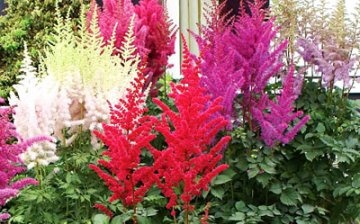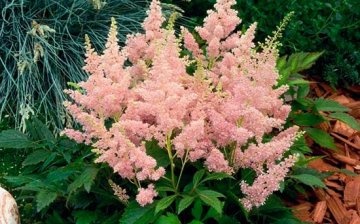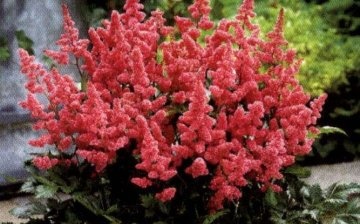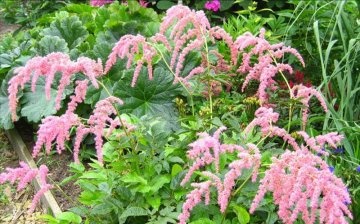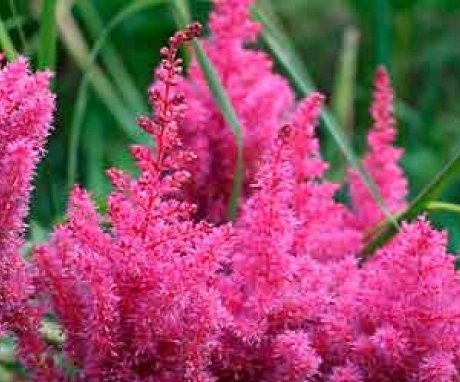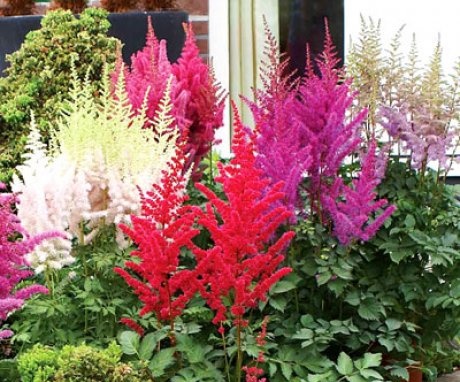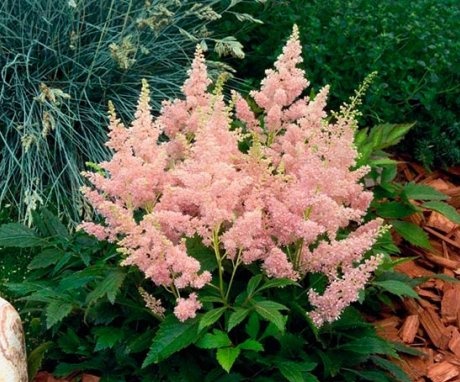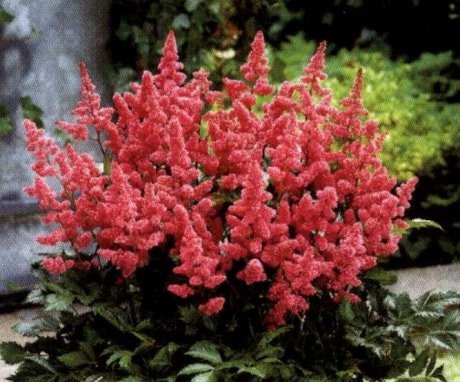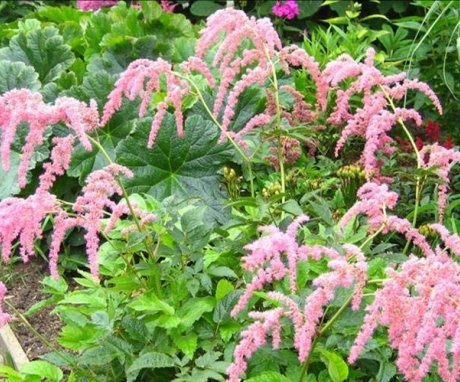Astilba: varieties and growing conditions
Astilba - an original plant, which, thanks to its long lush flowering, has become one of the favorite among gardeners. It is a sprawling shade-loving bush that can be used as decoration for remote corners of the garden, which does not get too much sun. Astilba will attract attention throughout the warm season, not just during flowering.
Content:
- General view and features of astilba
- The main varieties of astilba
- How to grow astilba on the site?
- Growing astilba from seeds
- Diseases and common pests
General view and features of astilba
Astilba comes from the saxifrage family, it is a perennial ornamental plant, whose homeland is considered to be Japan and the eastern regions of Asia, it is also found in the wild in North America. It can have very different sizes: the height of the bush ranges from 15 to 200 centimeters. Today, about 40 species are known, and the number of bred varieties totals several hundred.
All varieties will have small flowers. They are collected in large inflorescences, the color of the buds can be very different: purple, red, pink, burgundy, etc.
Planting astilba will be the best solution if you are looking for an unpretentious, hardy shrub with a pleasant appearance.
The bushes can bloom during all summer months, after flowering they form boxes with seeds... Astilba leaves have a special decorative shape: they can be cut twice or thrice, which gives the bush a delicate delicate look. It also has a powerful rhizome with many shoots: this will allow Astilbe to fight drought and provide the plant with nutrients.
If you are interested in astilba, the varieties can be chosen according to many parameters: the bush can be short, dwarf or tall, different varieties differ in the duration of flowering and many other characteristics. The number of varieties continues to increase thanks to targeted breeding work.
The main varieties of astilba
Although the number of species and varieties is very large, only a few of them have gained wide popularity. Usually gardeners choose the following varieties of astilba for their own garden:
- Astilbe Ardens (the Latin name of the group is Arendsii Hybrida). The group includes more than 40 varieties based on David's astilbe. This group belongs to tall varieties: the height of the bush can exceed 100 cm. The shape of the bush can be spherical or pyramidal, the color of the buds changes from white to pink and dark red. These varieties will bloom from July to August, flowering duration is about 40 days. The group includes the following varieties: Weiss Gloria, Diamant, Rubin and many others.
- Chinese astilba is a group of tall varieties, the height of the shrub is up to 110 cm. It has large basal leaves, the leaves on the stem are smaller and less bright. The flowers are usually the characteristic lilac color, although there are several varieties with white and dark red flowers. This group includes the following varieties: Vision in Pink, Pumila Hybrida, Purpurlanze and some others, most of them can grow in well-lit areas.
- Japanese astilbe.It is a graceful plant and will be more compact than other varieties. The height of the bush is no more than 80 cm, the flowers will be pink or white. This is the earliest flowering variety, and the lush paniculate inflorescences will adorn the garden for a very long time. Another feature is increased resistance to low temperatures, the plant is not afraid of even severe cold weather. It has been cultivated for more than a century and a half, and today there are several dozen varieties in this group. Among them are Montgomery, Deutschland, Rhineland and many others.
- Common-leaved astilba is a group of the smallest varieties: the height of the bushes does not exceed 20-50 cm. The plant is distinguished by drooping inflorescences, giving it an aesthetic appearance, as well as an unusual shape of the leaves. This is a rather capricious plant, it does not tolerate sudden temperature changes and requires regular watering. Praecox Alba is one of the most spectacular varieties in this group - the lush white flowers will be great. decoration for shady corners of the garden.
Despite significant differences in appearance, all Astilba species have approximately the same growing requirements. In general, this is an unpretentious plant, for which it will be very easy to create optimal conditions.
How to grow astilba on the site?
One of the main features of astilba is that its rhizome gradually grows upward, while the underground part gradually dies off. So that the plant does not remain without food because of this, it will have to be spilled regularly, and the root system will need to be mulched to protect it from freezing. If this condition is met, it will be easy to achieve rapid growth: the basic requirements will be easy to fulfill.
Astilba grows well if several basic conditions are met:
- Astilba generally prefers shaded areas, so it can be placed in the shade of a house or large trees. You can specifically choose more light-loving varieties that will be more tolerant of their own rays, but more often astilbe is planted exactly where other plants begin to suffer from a lack of light.
- Correctly selected soil should have a pH level of 5.5-6.5, preferably loamy soils. The shrub grows best in an area with a high aquifer.
- Regular watering... Astilba does not like drying out of the soil, and if it is very hot outside, to water the bush can even be twice a day. It is advisable to use warm water for watering so as not to damage the root system. Mulching will make it possible to retain maximum moisture in the soil, and the earthen lump will not dry out.
- For feeding in the spring, nitrogen is used fertilizer: it is necessary to huddle the rhizome and add humus to the soil. At the beginning of summer, potassium nitrate is used for feeding in the amount of 2 tablespoons per 10 liters of water. At the end of summer, superphosphate is used for feeding: for each bush, about 20 g of phosphorus fertilizers are required. After processing its soil must be loosened so that fertilizers are better absorbed by the root system.
In one place, the bush can grow up to 20 years, but this will require strict adherence to the feeding schedule. Most often, the transplant is carried out every 5-7 years: it makes it possible to replace the soil and create optimal conditions for long flowering.
Growing astilba from seeds
Usually for breeding shrub vegetative methods are used:
- Can be applied dividing a bush
- Transplanting part of the rhizome with buds
But can be used to get a new plant the seeds: this will make it possible to continue breeding work and develop new varieties. It is necessary to recreate natural conditions in order to awaken the seeds to life and achieve successful growth.
Planting begins in May: the seeds must be planted in a container filled with peat and sand in equal proportions.
However, they are not placed directly into the ground: the soil must be covered with a thin layer of snow, over which they crumble the seeds... When melted, the snow moisturizes the seed coat and encourages growth. After disembarkation, the container is kept in the refrigerator for several weeks - this period is called stratification.
When the first shoots appear, the container must be transferred to a warm room with an air temperature of up to 22 degrees. When watering, you need to be very careful: moisture should not fall on the leaves, but strictly under the roots, otherwise you can destroy all the seedlings. When young plants have a few true leaves, they need to be dived into small pots.
Astilba is planted in the ground with the onset of warm days, usually planting is carried out in late May or early June.
Flowerbed dug up, you need to remove rhizomes from it weeds... Organic fertilizers are applied to the soil: it can be rotted compost, manure or peat, 1 bucket of fertilizers is required per square meter of the flower bed. Pits up to 30 cm deep are dug in the flower bed, the distance between them should be about 25 cm.A teaspoon is placed in each hole mineral fertilizer, after which the plants are planted. The soil needs to be mulched to retain moisture in the soil.
Diseases and common pests
Astilue, like other plants, is threatened by several common peststhat any gardener has to contend with. First of all, you will have to protect the plant from the following parasites:
- The slobbering penny is an insect that lays offspring in the leaf axils. The larvae feed on the sap of the plant, as a result of which it begins to turn yellow and wilt. A characteristic feature are spots of saliva-like secretions, for which the penny got its name. To get rid of the pest, you will have to treat the bush with special chemicals.
- Strawberry nematode - another leaf pest... It affects the leaf plates, and they begin to become covered with yellow spots. A large number of nematodes leads to leaf death, the plant slows down growth and may die.
- Gall nematode is a pest that affects the root system. This is especially dangerous as it interferes with the development of the plant and it can wither completely.
For prevention the appearance of pests, it is necessary to treat the soil with phytoverm, as well as to get rid of weeds in a timely manner. The first year of the plant's life is especially important: in the future, the rhizome grows and becomes more durable, so the weeds will not be able to interfere with it.
It is important to regularly inspect the plant in order to stop pests in time.
Astilba is an excellent decoration for the garden, and the requirements for its cultivation will not be difficult to comply with. It can grow for a very long time, and a lush bush will delight the owner with annual long flowering.
More information can be found in the video.





